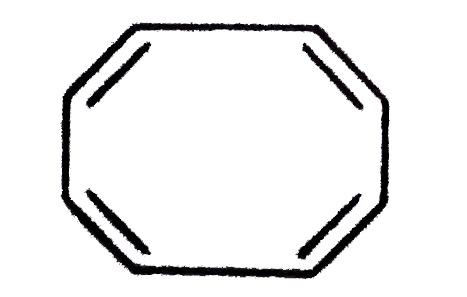Acetylene polymerizes to give
benzene
polyacetylene
butane
octane
The correct Answer is:A
To answer the question "Acetylene polymerizes to give," we can follow these steps:
Step 1: Understand the Polymerization Process
Acetylene (C₂H₂) can undergo polymerization, which is a chemical process where small molecules (monomers) combine to form a larger molecule (polymer). In this case, acetylene acts as the monomer.
Hint: Remember that polymerization involves the combination of smaller units to form larger structures.
Step 2: Identify the Conditions for Polymerization
The polymerization of acetylene typically requires specific conditions, including the presence of catalysts. In this case, chromium trioxide (CrO₃) and a silica-alumina catalyst are used.
Hint: Catalysts are substances that speed up chemical reactions without being consumed in the process.
Step 3: Determine the Product of Polymerization
When acetylene is polymerized under the right conditions (with chromium trioxide and silica-alumina catalyst), it produces benzene (C₆H₆). This can also occur when acetylene is passed over a red-hot copper tube.
Hint: Look for the end product of the reaction, which in this case is a well-known aromatic compound.
Step 4: Conclude the Answer
Thus, the polymerization of acetylene gives benzene.
Final Answer: Acetylene polymerizes to give benzene.
Acetylene (C₂H₂) can undergo polymerization, which is a chemical process where small molecules (monomers) combine to form a larger molecule (polymer). In this case, acetylene acts as the monomer.
The polymerization of acetylene typically requires specific conditions, including the presence of catalysts. In this case, chromium trioxide (CrO₃) and a silica-alumina catalyst are used.
When acetylene is polymerized under the right conditions (with chromium trioxide and silica-alumina catalyst), it produces benzene (C₆H₆). This can also occur when acetylene is passed over a red-hot copper tube.
Thus, the polymerization of acetylene gives benzene.
Topper's Solved these Questions
- CARBONBOOK - MCGROW HILL PUBLICATIONCHAPTER - CARBONEXERCISE - HIGHER ORDER THINKING QUESTIONS
10 Videos
- ACIDS , BASES AND SALTSBOOK - MCGROW HILL PUBLICATIONCHAPTER - ACIDS , BASES AND SALTSEXERCISE - HIGHER ORDER THINKING QUESTIONS
10 Videos
- CHEMICAL BONDINGBOOK - MCGROW HILL PUBLICATIONCHAPTER - CHEMICAL BONDINGEXERCISE - HIGHER ORDER THINKING QUESTIONS
10 Videos
Similar Questions
Knowledge Check
Acetylene polymerizes in the presence of Ni(CN)2 under pressure to form mainly
A BCH2=CH−C≡CHC
BCH2=CH−C≡CHC DCH2=CH−C≡C−CH=CH2
DCH2=CH−C≡C−CH=CH2Acetylene trimerises to give benzene. The reaction occurs in the presence of
AIronBSilicaC(C6H5)3+Ni(CO)4DCr2O3+p2o5Hydroxylamine (NH2OH) is manufacture in large quantities to make cycloexanone oxime, which is covnerted to caprolactam and then polymerized to give
ABakeliteBNylon-6CNylon -6, 6DMelmac
Monomers ethylene glycol and terephthalic acid undergo condensation polymerization to give polymer calls.
View SolutionLike acetylene, the homologues of acetylene can also polymerize. Which of the following will polymerize to give hexamethyl benzene?
View SolutionAcetylene on ozonolysis gives:
View SolutionAcetylene on hydration grives compound A, which on Clemmenson's reduction gives ?
View SolutionAcetylene gives
View Solution
